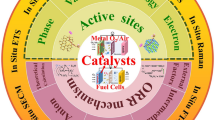Abstract
The authors have reviewed the salient features of the thermal behavior of the following systems:
-
(A)
Single oxide systems: (i) Cr2O3, (ii) Fe2O3, (iii) Al2O3, (iv) MnO2, (v) ZrO2, (vi) NiO, (vii) ZnO, (viii) TiO2, (ix) SiO2, (x) ThO2.
-
(B)
Binary oxide systems: (i) Cr2O3-Al2O3, (ii) Cr2O3-Fe2O3, (iii) Cr2O3-ZnO, (iv) Al2O3-SiO2, (v) Al2O3-Fe2O3, (vi) MnO-Cr2O3, (vii) Cu-Al2O3, (viii) ZrO2-Cr2O3, (ix) NiO-Cr2O3, (x) ZrO2-NiO, (xi) ThO2-Al2O3.
-
(C)
Ternary oxide systems: (i) NiO-Cr2O3-ZrO2, (ii) Fe2O3-Cr2O3-Al2O3.
-
(D)
Vanadates: (i) tin vanadate, (ii) copper vanadate, (iii) lead vanadate, (iv) cobalt vanadate and (v) silver vanadate.
Excellent correlations have been obtained in most of the systems between the thermal characteristics of the solids, as revealed by DTA, and their specific surface areas and catalytic activity.
Résumé
On a examiné les principales caractéristiques du comportement thermique des catalysateurs suivants, avec systèmes d'oxydes hétérogènes:
-
(A)
Systèmes d'oxydes simples: 1. Cr2O3, 2. Fe2O3, 3. Al2O3, 4. MnO2, 5. ZrO2, 6. NiO, 7. ZnO, 8. TiO2, 9. SiO2, 10. ThO2;
-
(B)
Systèmes d'oxydes binaires: 1. Cr2O3-Al2O3, 2. Cr2O3-Fe2O3, 3. Cr2O3-ZnO, 4. Al2O3-SiO2, 5. Al2O3-Fe2O3, 6. MnO-Cr2O3, 7. Cu-Al2O3 8. ZrO2-Cr2O3, 9. NiO-Cr2O3, 10. ZrO2-NiO, 11. ThO3-Al2O3;
-
(C)
Systèmes d'oxides ternaires: 1. NiO-Cr2O3-ZrO2; 2. Fe2O3-Cr2O3-Al2O3;
-
(D)
Vanadates: 1. d'étain, 2. de cuivre, 3. de plomb, 4. de cobalt, 5. d'argent.
Les caractéristiques thermiques des solides, observées par A. T. D., montrent une bonne concordance avec leurs surfaces spécifiques et leur activité catalytique.
Zusammenfassung
Es wurden die wichtigsten Kennzeichen des thermischen Verhaltens folgender heterogener Katalysator-Systeme untersucht.
-
(A)
Einfache Oxydsysteme: 1. Cr2O3, 2. Fe2O3, 3. Al2O3, 4. MnO2, 5. ZrO2, 6. NiO, 7. ZnO, 8. TiO2, 9. SiO2, 10. ThO2.
-
(B)
Binäre Oxydsysteme: 1. Cr2O3-Al2O3, 2. Cr2O3-Fe2O3, 3. Cr2O3-ZnO, 4. Al2O3-SiO2, 5. Al2O3-Fe2O3, 6. MnO-Cr2O3 7. Cu-Al2O3, 8. ZrO2-Cr2O3, 9. NiO-Cr2O3, 10. ZrO2-NiO, 11. ThO2-Al2O3.
-
(C)
Ternäre Oxydsysteme: 1. NiO-Cr2O3-ZrO2, 2. Fe2O3-Cr2O3-Al2O3.
-
(D)
Vanadate: 1. Zinn-, 2. Kupfer-, 3. Blei-, 4. Kobalt-, 5. Silbervanadate.
Gute Übereinstimmung konnte zwischen den durch DTA Messungen gefundenen thermischen Kennzeichen der festen Substanzen und ihren spezifischen Oberflächen, sowie der katalytischen Aktivität festgestellt werden.
Резюме
Исследованы характе рные свойства термического поведе ния следующих систем:
-
(A)
Одинарные системы ок исей: (I) Сr2О3, (II) Fe2O3 (III) Аl2О3, (IV) MnO2, (V) ZrO2, (VI) NiO, (VII) ZnO, (VIII) TiO2, (IX) SiO2, (X) ThO2. (Б) Бинарные системы ок исей: (I) Cr2O3- Al2O3, (II) Cr2O3-Fe2O3, (III) Cr2O3-ZnO, (IV) Аl2О3-SiO2, (V) Al2O3-Fe2O3, (VI) MnO-Cr2O3, (VII) Cu- Al2O3, (VIII) ZrO2 Cr2O3, (IX) NiO-Cr2O3, (X) ZrO2-NiO, (XI) ThO2- Al2O3.
-
(B)
Тройные системы окис ей: (I) NiO-Cr2O3-ZrO2, (II) Fe2O3-Cr2O3 Al2O3.
(Г) Ванадаты: (2) ванадат о лова, (II) ванадат меди, (III) в анадат свинца, (IV) ванадат коба льта, и (V) ванадат серебра.
В большинстве систем методом дифференциа льного термического анализ а (ДТА) найдена отличная кор реляция, между термич ескими характеристиками ис следуемых веществ, их поверхностью и кат алитической активно стью.
Similar content being viewed by others
References
S. K. Bhattacharyya andV. S. Ramchandran, J. Sci. Industr. Res., 12 (1952) 549, 550.
S. K. Bhattacharyya andV. S. Ramchandran, J. Sci. Industr. Res., B12 (1953) 279.
S. K. Bhattacharyya andV. S. Ramchandran, J. Sci. Engng. Res. (I. I. T., Kharagpur), 1 (1957) 73.
S. K. Bhattacharyya andV. S. Ramchandran, Bull. Nat. Inst. Sci. India, 12 (1959) 23. (Proc. of the Symposium on Contact Catalysis, 1956, Calcutta.)
S. K. Bhattacharyya, V. S. Ramchandran andJ. C. Ghosh, Adv. in Catalysis, Academic Press Inc., New York, Vol. IX, 1957, p. 114. (Proc. Int. Congr. on Catalysis, 1956, Philadelphia.)
S. K. Bhattacharyya andS. Kameswari, Bull. Nat. Inst. Sci. India, 12 (1959) 43.
S. K. Bhattacharyya andS. Kameswari, J. Chim. phys., 56 (1959) 823.
S. K. Bhattacharyya, S. Kameswari andG. Srinivasan, Z. phys. Chem., 214 (1960) 191.
S. K. Bhattacharyya andN. D. Ganguly, Proc. Nat. Inst. Sci. India, 27A (1961) 588.
S. K. Bhattacharyya, G. Srinivasan andN. D. Ganguly, J. Indian Chem. Soc., 41 (1964) 233.
S. K.Bhattacharyya, Proc. First Int. Congr. Thermal Analysis, Aberdeen, 1965, p. 239.
S. K.Bhattacharyya, G. S.De and N. C.Datta, Proc. Second Int. Congr. Thermal Analysis, Worcester, 1968.
S. K.Bhattacharyya and J.Ghosh, Proc. Second Int. Congr. Thermal Analysis, Worcester, 1968.
Griffith et al., Nature, 172 (1953) 77.
Griffith et al., Proc. Roy. Soc., A 224 (1954) 412, 419, 426.
M. Domine-Burges, Compt. Rend., 228 (1949) 1435.
Berezovskaya andSemikhatova, J. Phys. Chem. (U.S.S.R.), 7 (1936) 939.
J. Brenet andA. M. Briot, Compt. Rend., 232 (1951) 1300, 2021.
H. Pichler andK. H. Ziesecke, Bull. U.S. Bur. Min., 488 (1950) 34.
W. O. Milligan andL. Merten, J. Phys. Coll. Chem., 51 (1947) 521.
W. O. Milligan andJ. Holmes, J. Am. Chem. Soc., 63 (1941) 149.
H. B. Weiser, W. O. Milligan andG. A. Mills, J. Phys. Coll. Chem., 52 (1948) 942.
W. O. Milligan andL. Merten, J. Phys. Chem., 50 (1946) 465.
R. P. Eischens andP. W. Selwood, J. Am. Chem. Soc., 70 (1948) 227.
A. G. Oblad, T. H. Milliken andG. A. Mills, Adv. in Catalysis, Academic Press Inc., New York, Vol. III, 1951, p. 199.
V. N. Ipatieff andG. S. Monroe, J. Am. Chem. Soc., 61 (1945) 2168.
M. Taniguchi andT. R. Ingraham, Can. J. Chem., 42 (1964) 2467.
N. Strupler, Compt. Rend., 255 (1962) 527.
Author information
Authors and Affiliations
Rights and permissions
About this article
Cite this article
Bhattacharyya, S.K., Datta, N.C. The application of differential thermal analysis technique to the study of single, binary and ternary oxide catalyst systems. Journal of Thermal Analysis 1, 75–96 (1969). https://doi.org/10.1007/BF01911248
Received:
Issue Date:
DOI: https://doi.org/10.1007/BF01911248




